2019 Lift Truck Survey: Improving warehouse efficiencies, optimizing operations
As e-commerce, omni-channel and rapid fulfillment continue to evolve, the need for efficient lift trucks that can handle the workload is expanding year over year.
Latest Logistics News
Shipment and expenditure decreases trend down, notes Cass Freight Index March trucking tonnage trends down, reports ATA FTR Shippers Conditions Index enters negative territory DAT March Truckload Volume Index sees modest March gains National diesel average, for week of April 22, is down for the second straight week More NewsWith the e-commerce boom in full swing and more companies looking to optimize fulfillment in the warehouse and DC, the lift truck is becoming an even more integral part of those operations. No longer related to just dragging around a few pallets of product per day, these vehicles are truly the workhorses of the modern day warehouse.
This year’s Peerless Research Group and Modern Materials Handling “Lift Truck Acquisition & Usage Study” proves this point, and more. For this year’s study, the two entities fielded e-mail responses from 128 readers.
Every respondent is involved in the evaluation and purchase of lift trucks for their facilities, which included warehousing (17%), DCs (36%), and manufacturing facilities (35%). The bulk of the respondents (69%) work in manufacturing, followed by wholesale trade (14%), retail trade (2%), third-party logistics providers (4%), and transportation/warehousing services (5%). On average, these readers work for companies that have 367 employees and $897 million in annual revenues.
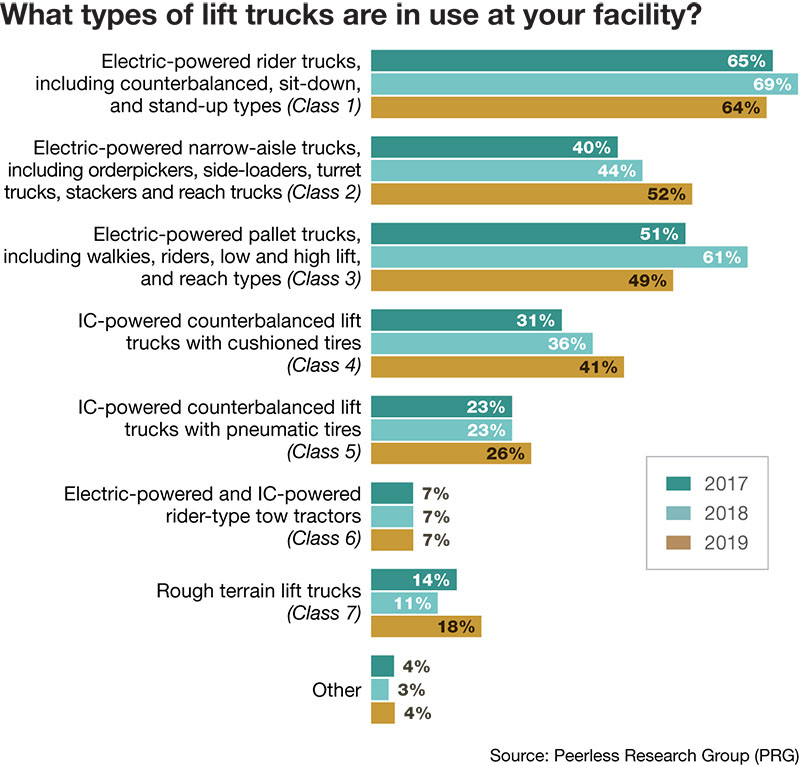
Who’s using what?
This year, 64% of companies are using electric-powered rider trucks (including counterbalanced, sit-down and stand-up types [Class 1]), while 52% use electricpowered narrow-aisle trucks (orderpickers, side-loaders, turret trucks, stackers and reach trucks [Class 2]). And, 49% of companies rely on electric-powered pallet trucks, 41% on internal combustion (IC) powered counterbalanced lift trucks (Class 4), and 26% use IC-powered lift trucks with pneumatic tires (Class 5).
Other types of lift trucks currently in use in the warehouse or DC setting include electric-powered and IC-powered rider-type tow tractors (Class 6) and rough terrain lift trucks (Class 7). Over the last year, the percentage of Class 1 users dropped five percentage points, the number of Class 2 lift truck users increased by 6 percentage points, and the volume of Class 3 users decreased by 12%.
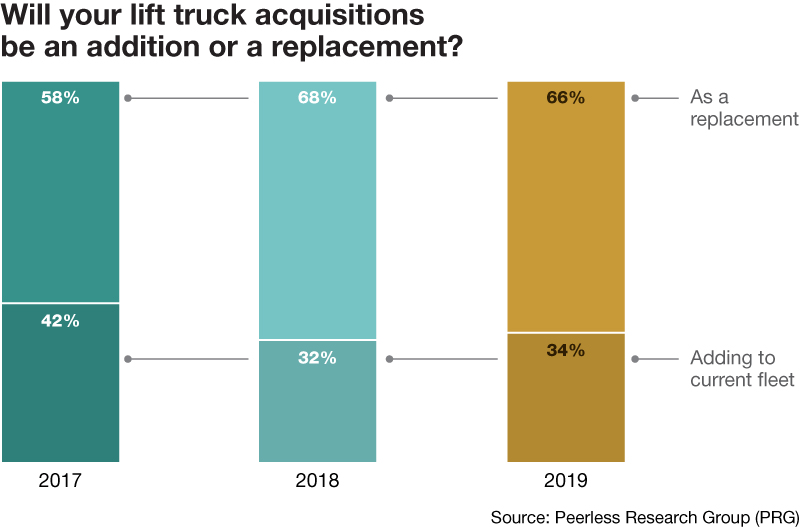
Replacement and retirement schedules
The bulk of respondents (34%) expect to be able to use their lift trucks for 10+ years, while 29% see the typical lifespan at five to eight years for these types of vehicles. These expectations haven’t shifted much over the last three years, with most companies expecting to have to switch out or retire their lift trucks every 7.7 years (compared to 7.9 years in 2018 and 7.8 years in 2017).
When asked whether their lift truck acquisitions will be additions or replacements, 34% of respondents say they’ll be adding to an existing fleet (compared to 32% in 2018) while 66% plan to use the new acquisitions to replace current vehicles (versus 68% last year).
In terms of how companies are handling the rotation and disposal of their vehicles, 50% plan to resell the lift trucks that are being replaced (versus 49% last year). Another 38% expect the dealer to take their older trucks when the new ones are delivered (compared to 33% who said this last year), and 26% will hold onto/store the lift trucks just in case they need them (versus 25% in 2018).
And, 13% of companies will hold on to their old lift trucks for spare parts (compared to 18% who said this last year).
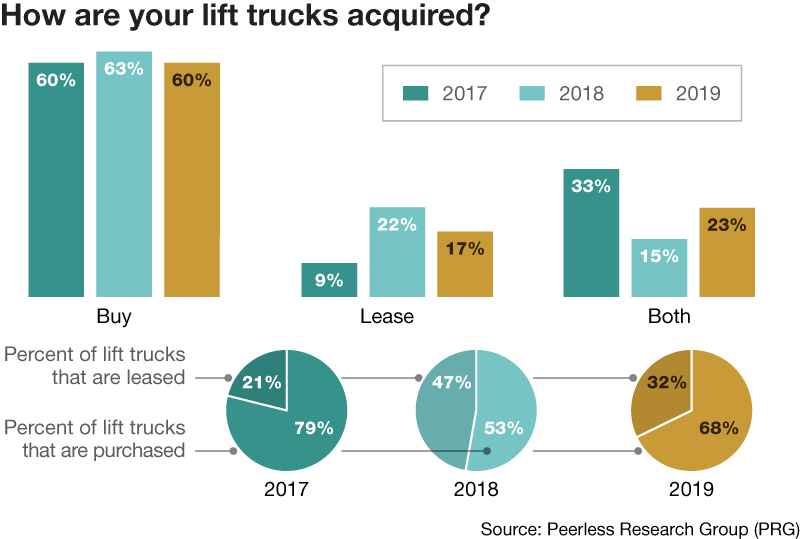
Core lift truck fleets
This year, 44% of companies say they operate core lift truck fleets, down from 49% last year but up over 2017’s 40% number. To fill out those fleets, 60% of companies will buy their vehicles outright (down from 63% in 2018); 17% plan to lease (versus 22% last year); and 23% plan to use a mix of both buying approaches (up from 15% in 2018).
On average, 68% of companies plan to purchase and 32% expect to lease their lift trucks (compared to 53% and 47%, respectively, in 2018). When asked about the impact that the current business climate has on their lift truck acquisition strategies, some said the economy as a whole has a great impact on those decisions. Business must be good to be able to spend on new equipment, they said, and demand drives profitability and available capital.
“If production is down, we wait until we get busy,” one respondent said in the survey. “If we don’t have a good solid business volume for a while, I won’t spend money on a new forklift,” another wrote.
Other respondents say the economy has some impact on their lift truck purchase decisions. Key concerns included the level of demand for warehouse space; the need to expand fleets as sales increase; and the need to eke more out of an existing fleet when capital is tight.
“The company that I represent has multiple buildings in close proximity to each other that are supported through forklift activity such as storing parts, moving to the next operation, and loading at a specific shipping point,” one respondent explained.
“Forklifts are decided by the configuration of the organization in what is needed to support the different operations; space utilization determines fleet size. If the economy is bad, we may still need the same number of trucks, but for [fewer hours].”
Of the companies that said economic factors had zero impact on their lift truck acquisition decisions, some said it’s simply a cost of doing business, and not one that ebbs and flows along with economic conditions.
“We don’t stop paying the power bill because of the economy,” one respondent noted. “Getting out of trucks at the right time can generate positive cash flow and save money from a total cost of ownership perspective. We can’t think of it as just a single, one-time sourcing expense.”
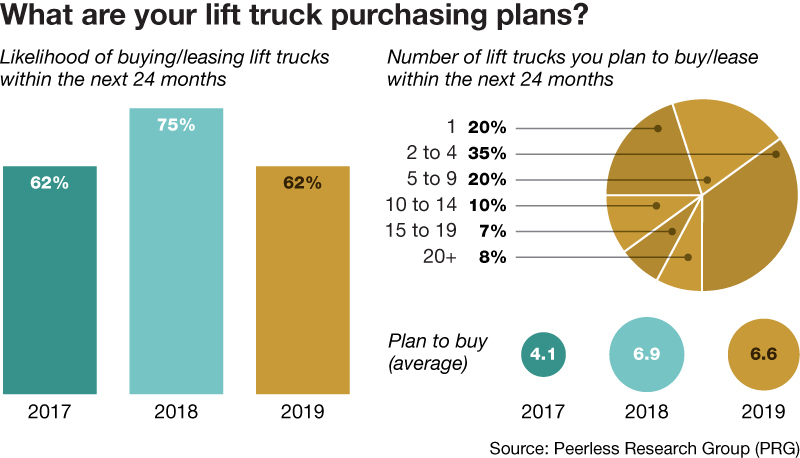
Buy or lease?
Looking ahead, 62% of companies plan to buy or lease new lift trucks within the next 24 months (down from 75% in 2018). In estimating the total number of trucks they’ll be acquiring, the majority of respondents (35%) will buy two to four vehicles, while an equal number (20%) expect to buy either one lift truck or five to nine total vehicles.
Ten percent say they’ll purchase 10 to 14 lift trucks, and 8% plan to buy more than 20 vehicles. On average, companies will acquire 6.6 new trucks in the next two years, down from 6.9% in 2018, but up over 2017’s average of 4.1%.
Assessing their lift truck spending plans for the upcoming 12 months, 50% of companies expect to spend less than $50,000 on those acquisitions; 17% will spend between $100,000 and $249,000; and 14% will shell out anywhere from $50,000 to $99,999; 8% say they’ll spend $250,000 to $499,999; and 4% will spend $1 million or more.
On average, companies expect to spend $185,420 on new forklifts over the next year (up from $149,040 in 2018), with a median expenditure of $50,000 (down from $68,750 last year). Most companies (89%) will get their new lift trucks directly from a dealer (up from 82% in 2018), while 20% will buy direct from the manufacturer (down from 23% last year).

Keeping them running
The lift truck parts that companies are most likely to purchase or replace this year include batteries and battery accessories (63%); wheels and tires (62%); tune-up parts (51%); brake components (49%); and chemicals, lubricants and oil (49%). These estimates all fall within a percentage point or two of last year’s reader input.
To train their lift truck operators, 85% of companies use internal training programs (up from 78% last year), 14% turn to their dealers for help in this area (down from 15% in 2018), and 14% work with independent service providers (even with last year’s number).
To service and maintain their lift trucks, 32% of respondents rely on in-house staff (compared to just 20% in 2018); 44% outsource to lift truck dealers (versus 53% last year); and 20% outsource to maintenance/service contractors (23% in 2018).
Software continues to play an important role in lift truck fleet management. According to the survey, 39% of companies have adopted technology to help them manage their fleets. The number is up from 2017, which was 34%, but has fallen from a 2018’s technology usage estimate of 49%.
More specifically, 76% of companies are using technology to track the cost to maintain their vehicles; 76% are using it for safety reasons (i.e., recording and tracking accidents, injuries, etc.); and 73% rely on technology to provide accurate maintenance histories.
Other reasons companies use technology in conjunction with their lift truck fleets include monitoring the age of their vehicles, tracking the cost to operate them, and overseeing utilization levels.
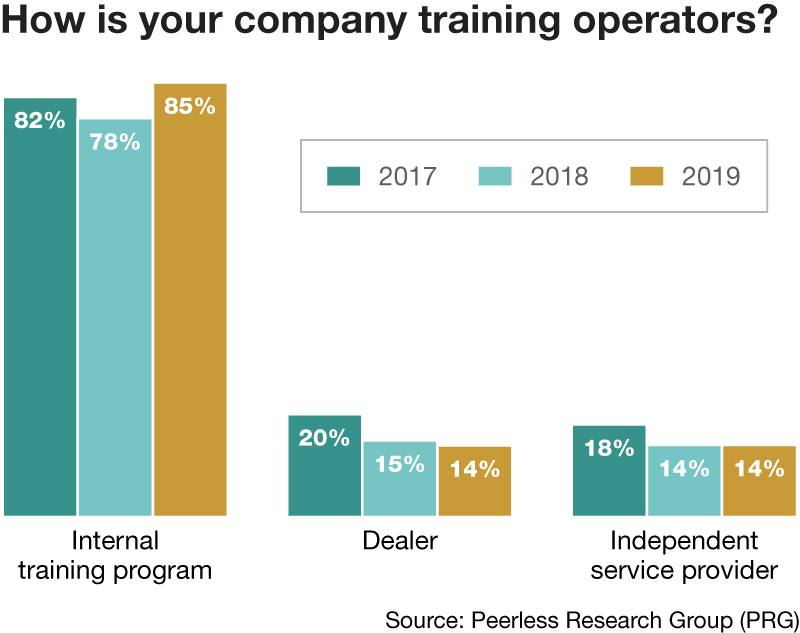
According to the survey, organizations are realizing positive results from their investments in fleet management technologies. Thirteen percent say the results have been “extremely successful” (up from 8% last year), 41% have posted “very successful” results (versus 29% in 2018), and 3% deem the initiatives “not very successful” (down from 4% last year). When asked why they’re not planning to use fleet management technology, respondents cited cost as one of the biggest roadblocks.
Others couldn’t see the direct benefit that this investment would provide at the operational level, and some said their fleets were too small to warrant it. “We’re a small business that deals with this type of equipment on an as-needed basis,” said one reader. “They’re not driven all day.”
As the picture of the autonomous lift truck continues to slowly come into view, more companies are embracing the idea of driverless vehicles in their warehouses and DCs.
When asked about their adoption of autonomous or semi-autonomous forklift technology, 21% of companies say that they’re using or planning to evaluate or acquire these types of vehicles, which include dual-mode or remote control based options. This number has risen gradually from 11% in 2017 to 14% last year, and will likely continue to climb as autonomous technology evolves and matures.

Article Topics
Latest in Logistics
Shipment and expenditure decreases trend down, notes Cass Freight Index March trucking tonnage trends down, reports ATA FTR Shippers Conditions Index enters negative territory DAT March Truckload Volume Index sees modest March gains National diesel average, for week of April 22, is down for the second straight week UPS reports first quarter earnings decline LM Podcast Series: Assessing the freight transportation and logistics markets with Tom Nightingale, AFS Logistics More LogisticsAbout the Author
Subscribe to Logistics Management Magazine

Find out what the world's most innovative companies are doing to improve productivity in their plants and distribution centers.
Start your FREE subscription today.
April 2023 Logistics Management

Latest Resources














